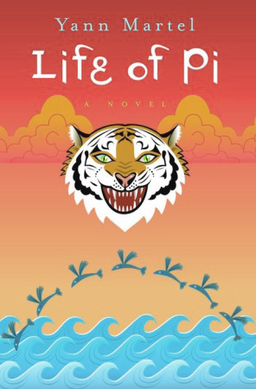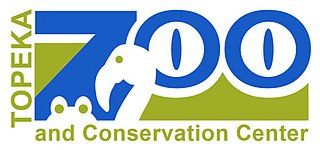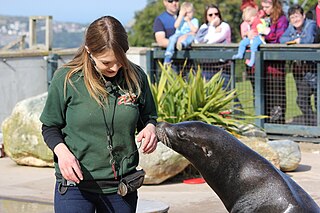
The Bronx Zoo is a zoo within Bronx Park in the Bronx, New York. It is one of the largest zoos in the United States by area and is the largest metropolitan zoo in the United States by area, comprising 265 acres (107 ha) of park lands and naturalistic habitats separated by the Bronx River. On average, the zoo has 2.15 million visitors each year as of 2009. The zoo's original permanent buildings, known as Astor Court, were designed as a series of Beaux-Arts pavilions grouped around the large circular sea lion pool. The Rainey Memorial Gates were designed by sculptor Paul Manship in 1934 and listed on the National Register of Historic Places in 1972.

The San Diego Zoo is a zoo in San Diego, California, located in Balboa Park. The zoo houses over 12,000 animals of more than 680 species and subspecies. It is the most visited zoo in the United States. Travelers have cited it as one of the best zoos in the world. The zoo was a pioneer in the concept of open-air, cage-less exhibits that recreate natural animal habitats. It sits on 100 acres of land leased from the City of San Diego.

Life of Pi is a Canadian philosophical novel by Yann Martel published in 2001. The protagonist is Piscine Molitor "Pi" Patel, an Indian boy from Pondicherry, India, who explores issues of spirituality and metaphysics from an early age. After a shipwreck, he survives 227 days while stranded on a lifeboat in the Pacific Ocean with a Bengal tiger, raising questions about the nature of reality and how it is perceived and told.

Woodland Park Zoo is a wildlife conservation organization and zoological garden located in the Phinney Ridge neighborhood of Seattle, Washington, United States. The zoo is the recipient of over 65 awards across multiple categories. The zoo has around 900 animals from 250 species and the zoo has over 1 million visitors a year.

Omaha's Henry Doorly Zoo and Aquarium is a zoo in Omaha, Nebraska. It is accredited by the Association of Zoos and Aquariums and a member of the World Association of Zoos and Aquariums. In August 2014, TripAdvisor rated it the "world's best zoo", ahead of the San Diego Zoo and Loro Parque, based on an algorithmic assimilation of millions of reviews for 275 major zoos worldwide.

The Cleveland Metroparks Zoo is a 183-acre (74 ha) zoo in Cleveland, Ohio. The Zoo is divided into several areas: Australian Adventure; African Savanna; Northern Wilderness Trek, The Primate, Cat & Aquatics Building, Waterfowl Lake, The RainForest, Asian Highlands, and the newly added Susie's Bear Hollow. Cleveland Metroparks Zoo has one of the largest collections of primates in North America, The Zoo is a part of the Cleveland Metroparks system.

The Queens Zoo is an 11-acre (4.5 ha) zoo at Flushing Meadows–Corona Park in Queens, New York City, between Grand Central Parkway and 111th Street. The zoo is managed by the Wildlife Conservation Society and is accredited by the Association of Zoos and Aquariums (AZA). Built along with the Queens Zoo is a children's zoo, which was originally called the Heckscher Children's Farm.

Brookfield Zoo Chicago, also known as the Chicago Zoological Park, is a zoo located in the Chicago suburb of Brookfield, Illinois. It houses around 450 species of animals in an area of 216 acres (87 ha). It opened on July 1, 1934, and quickly gained international recognition for using moats and ditches instead of cages to separate animals from visitors and from other animals. The zoo was also the first in America to exhibit giant pandas, one of which has been taxidermied and put on display in Chicago's Field Museum of Natural History. In 1960, Brookfield Zoo Chicago built the nation's first fully indoor dolphin exhibit, and in the 1980s, the zoo introduced Tropic World, the first fully indoor rainforest simulation and the then-largest indoor zoo exhibit in the world.

The Prospect Park Zoo is a 12-acre (4.9 ha) zoo located off Flatbush Avenue on the eastern side of Prospect Park, Brooklyn, New York City. As of 2016, the zoo houses 864 animals representing about 176 species, and as of 2007, it averaged 300,000 visitors annually. The Prospect Park Zoo is operated by the Wildlife Conservation Society (WCS). In conjunction with the Prospect Park Zoo's operations, the WCS offers children's educational programs, is engaged in restoration of endangered species populations, runs a wildlife theater, and reaches out to the local community through volunteer programs.

An aviary is a large enclosure for confining birds, although bats may also be considered for display. Unlike birdcages, aviaries allow birds a larger living space where they can fly; hence, aviaries are also sometimes known as flight cages or bird cages in some places in the United Kingdom. Aviaries often contain plants and shrubbery to simulate a natural environment.

The Minnesota Zoo is an AZA-accredited zoo in Apple Valley, Minnesota. The zoo is one of two state-supported zoos in the United States, with the other being the North Carolina Zoo. When it opened on May 22, 1978, it was fairly revolutionary in its exhibit design. The zoo, built in a suburbanizing rural area, had more space to house exhibits and was one of the first zoos to organize its animals by their living environment as opposed to their species.

The Topeka Zoo is a medium-sized zoo in Topeka, Kansas in the United States. It is located within Gage Park, just off I-70 in the north central portion of the city. Despite its size, it houses over 300 animals in a number of exhibits, including one of the first indoor tropical rain forests in the United States. It is one of the most popular attractions in Topeka, with over 250,000 visitors a year.
"Dino" Don Lessem is a writer of more than 50 popular science books, specializing in dinosaurs. He was the founder of the Dinosaur Society and the Jurassic Foundation, which collectively have raised millions of dollars for dinosaur research. He is the CEO and founder of Dino Don, Inc., an animatronics company specializing in dinosaurs, dragons, and sea creatures.

Paignton Zoo is a zoo in Paignton, Devon, England. The zoo was started as a private collection by avid animal collector and breeder, Herbert Whitley, in the grounds of his home Primley House. It was opened to the public on a number of occasions, originally as Primley Zoological Gardens, and closed twice due to disputes with the tax authorities. The commercialisation of the zoo came when animals and attractions were relocated from Chessington Zoo during World War II, and the site was named as Devon's Zoo and Circus

A zoo is a facility in which animals are kept within enclosures for public exhibition and often bred for conservation purposes.

Southwick's Zoo, New England's Largest Zoo, is a privately owned and seasonally operated zoological park spanning 300 acres in Mendon, Massachusetts, United States. The zoo was established in 1963 and has been under the management of the Southwick and Brewer families since its inception. Established in 1963, the zoo is home to more than 850 animals from various regions of the world, offering visitors a chance to observe over 165 species of exotic animals.

A nocturnal house, sometimes called a nocturama, is a building in a zoo or research establishment where nocturnal animals are kept and viewable by the public. The unique feature of buildings of this type is that the lighting within is isolated from the outside and reversed; i.e. it is dark during the day and lit at night. This is to enable visitors and researchers to more conveniently study nocturnal animals during daylight hours.

Yann Martel, is a Canadian author who wrote the Man Booker Prize–winning novel Life of Pi, an international bestseller published in more than 50 territories. It has sold more than 12 million copies worldwide and spent more than a year on the bestseller lists of the New York Times and The Globe and Mail, among many other best-selling lists. Life of Pi was adapted for a movie directed by Ang Lee, garnering four Oscars including Best Director and winning the Golden Globe Award for Best Original Score.

Max and the Cats is a 1981 novella by Brazilian writer and physician Moacyr Scliar. It was first published in Portuguese, then published in English in 1990. It tells the story of Max Schmidt, born in Berlin in 1912, who comes of age just before the Nazis take power. After offending them by having an affair with a married woman, Max is forced to flee the country. He ends up on a ship bound for Brazil that sinks as part of an insurance scam and finds himself trapped in a dinghy with a jaguar—one of a number of zoo animals caged in the hold—but after being rescued and making a life for himself in Brazil continues to find his German past impossible to escape.

Pattycake, also known as Patty Cake was a female western lowland gorilla born to Lulu and Kongo at the Central Park Zoo in New York City. She was the first baby gorilla successfully born in captivity in New York. Months after her much publicized birth, Pattycake's arm was broken when it got stuck in her cage as her mother grabbed her away from her father. The incident was sensationally anthropomorphized in the media as a domestic dispute between Lulu and Kongo, but in reality experts thought it was a simple accident.



















